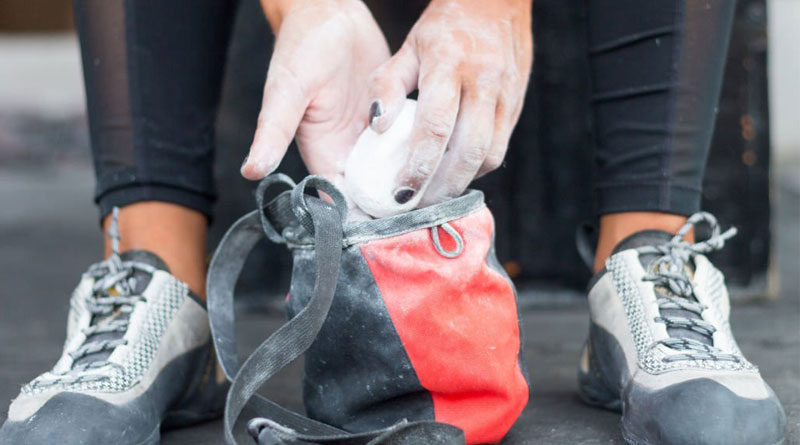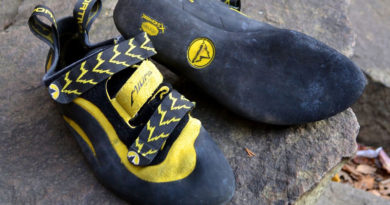Chalk Ball vs. Loose Chalk: What’s the Difference?
Rock climbers use chalk to strengthen their grip on climbing supports. It’s comprised of magnesium carbonate, which absorbs sweat and moisture from the hands and helps to keep them from slipping. Before climbing, rock climbers generally apply chalk to their palms to assist establish a strong grasp on the holds. Chalk balls and loose chalk are both forms of chalk that rock climbers use, but they differ in their application and usage.
What is a Chalk Ball?
A chalk ball is a compact, tightly packed ball of chalk that is contained within a mesh or fabric bag. Climbers use a chalk ball by squeezing it to discharge a small bit of chalk onto their hands. The benefit of utilizing a chalk ball is that it reduces the amount of chalk released into the environment. It lowers the chance of making a mess and leaving chalk residue on the climbing holds. Furthermore, a chalk ball enables you to release a controlled amount of chalk. With a chalk ball, you can more accurately manage the amount of chalk applied to your hands.
What is a Loose Chalk?
Loose chalk, on the other hand, is just bulk chalk that has not been packaged in a ball or bag. Climbers apply loose chalk to their hands by dipping them into a bag of chalk or sprinkling it directly on their hands. Loose chalk is less expensive than chalk balls, which allows you to apply a bigger amount of chalk to your hands. The disadvantage of using loose chalk is that it is more likely to create a dust cloud. It also leaves chalk residue on the climbing holds and surrounding area. These two disadvantages make loose chalk messier, which has a bigger environmental impact.
Environmental Impact
The environmental impact of chalk in rock climbing is a topic of debate within the climbing community. Both chalk balls and loose chalk have their own unique impact on the environment. Let’s discuss them one by one.
When compared to loose chalk, chalk balls have a smaller environmental impact. This is because chalk balls are confined within a mesh or cloth bag. The amount of chalk emitted into the environment is also reduced. Controlled chalk release from a chalk ball also decreases the chance of creating a dust cloud. Chalk dust can be hazardous to both climbers and the surrounding environment.
Loose chalk, on the other hand, has a bigger environmental impact because it is not contained within a ball or bag. Climbers are more likely to create a dust cloud and leave chalk residue on the climbing holds and surrounding area when they apply loose chalk to their hands. This can be hazardous to the local habitat and fauna. Dust can also have a bad impact on the aesthetic of the climbing area.
Messiness
Chalk balls are less messy than loose chalk. This is because the chalk is confined in a mesh or cloth bag. It is less likely to produce a dust cloud and leave chalk residue on the climbing holds and surrounding area. The controlled release of chalk allows climbers to manage how much chalk they apply to their hands. It lowers the risk of over-application and unwanted messiness.
Loose chalk, on the other hand, is messier because it isn’t contained within a ball or bag. As I mentioned before, climbers are more likely to create a cloud of dust, which can impact the surroundings. This can be inconvenient for climbers and have an impact on the look of the climbing area. Finally, when you dip their hands into a bag of loose chalk, you make a mess within the bag. This messed up bag can be difficult to close and transport.
Control of Application
When compared to loose chalk, chalk balls offer more control over the application of chalk. You can precisely control the amount of chalk you apply to your hands by squeezing the ball. This enables you to use only the amount of chalk required, eliminating the possibility of over-application and waste. Regulated chalk release from a chalk ball reduces the amount of chalk discharged into the surroundings. It lowers the chance of leaving a chalk residue on the climbing holds.
Loose chalk, on the other hand, gives you less control over how much chalk you use. You usually sprinkle loose chalk directly on your hands or dip your hands into a bag of chalk. This results in over-application and wasted chalk. The inability to regulate the application of loose chalk increases the risk of making a sloppy mess.
Cost
The cost of climbing chalk can vary depending on the brand, size, and quantity.
On a per-unit basis, loose chalk is often less expensive than chalk balls. However, climbers often use more loose chalk than a chalk ball, which can counteract the early cost savings and make loose chalk more expensive in the long term. Further, loose chalk can be messy and produce a dust cloud, resulting in waste and the need for regular reapplication.
Chalk balls are often more expensive per unit than loose chalk but they are more handy and efficient to use. Chalk balls’ enclosed form lessens the possibility of over-application and wasted chalk, as well as the amount of chalk released into the environment. In the long run, this can lead to more efficient and cost-effective chalk utilization.
Conclusion
Chalk balls and loose chalk are both common types of chalk that rock climbers use. Each type of chalk has its own set of advantages and downsides. Chalk balls offer greater control over chalk application and are generally less untidy and cost-effective in the long term. Loose chalk, on the other hand, is more widely available and less expensive per unit. When deciding between chalk balls and loose chalk, consider things like messiness, cost, and environmental impact. The most important thing, in the end, is to use chalk ethically and to minimize its influence on the environment and climbing area.




